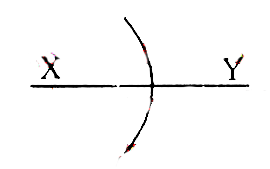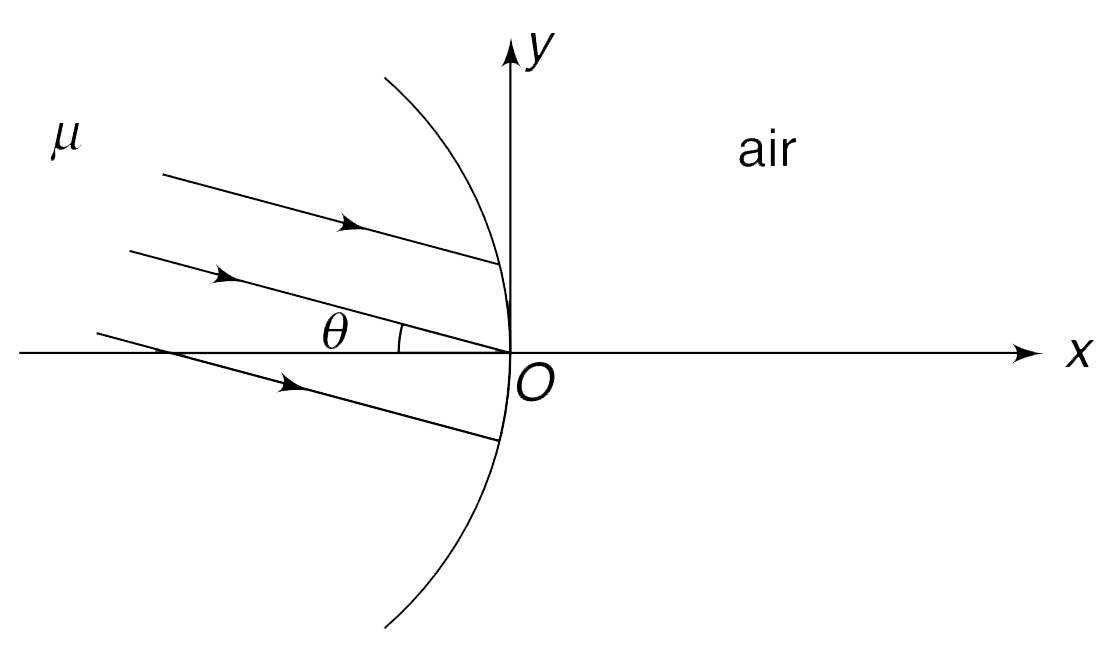A convex spherical refracting surface with radius R separates a medium having refractive index 5/2 from air. As an object is moved towards the surface from far away from the surface along the principle axis, its image
changes from real to virtual when it is at a distance R from the surface
changes from virtual to real when it is at a distance R from the surface
changes from real to virtual when it is at a distance 2R/3 from the surface
changes from virtual to real when it is at a distance 2R/3 from the surface
The correct Answer is:c.
2.5v−1−u=2.5−1R
2.5v=1.5R−1u
v=2.5uR1.5u−R
v=∞at1.5u−R=0
u=R3
For t–2R3,v=0, virtual image
u>2R3,v=0, real image
So, image is changing from real to virtual at u=2R3

Topper's Solved these Questions
- BOOK - CENGAGE PHYSICSCHAPTER - GEOMETRICAL OPTICSEXERCISE - Assertion-Reasoninig2videos
GEOMETRICAL OPTICS
- BOOK - CENGAGE PHYSICSCHAPTER - GEOMETRICAL OPTICSEXERCISE - Linked Comprehension51videos
GEOMETRICAL OPTICS
- BOOK - CENGAGE PHYSICSCHAPTER - GEOMETRICAL OPTICSEXERCISE - Subjective26videos
GEOMETRICAL OPTICS
- BOOK - CENGAGE PHYSICSCHAPTER - FRICTIONEXERCISE - QUESTION BANK1videos
FRICTION
- BOOK - CENGAGE PHYSICSCHAPTER - GRAVITATIONEXERCISE - Question Bank39videos
GRAVITATION
Similar Questions
A concave spherical surface of radius of curvature 100 cm separates two media of refractive indices 1.50 and 43. An object is kept in the first medium at a distance of 30 cm from the surface. Calculate the position of the image.
View SolutionA convex surface of radius of curvature 40 cm separate two media of refractive indices 43 and 1.50. An object is kept in the first medium at a distance of 20 cm from the surface. Calculate the position of the image.
View Solution
Knowledge Check
- Question 1 - Select One
A concave spherical refractive surface with radius R separates a medium of refractive index 5/2 from air. As an object is approaching the surface from far away from the surface along the central axis, its image
Aalways remains realBalways remains virtualCchanges from real to virtual at a distance 2R/3 from the surfaceDchanges from virtual to real at a distance 2R/3 from the surface - Question 2 - Select One
A concave spherical surface of radius of curvature 10 cm separates two medium x & y of refractive index 4/3 & 3/2 respectively. If the object is placed along principal axis in medium X then
 Aimage is always realBimage is real if the object distance is greater than 90cmCimage is always virtualDimage is virtual if the object distance is less than 90 cm
Aimage is always realBimage is real if the object distance is greater than 90cmCimage is always virtualDimage is virtual if the object distance is less than 90 cm
A convex refracting surface of radius of curvature 20cm separates two media of refractive indices 4/3and1.60. An object is placed in the first medium (μ=4/3) at a distance of 200cm from the refracting surface. Calculate the position of image formed.
View SolutionA spherical surface of radius R separates air from a medium of refractive index μ. Parallel beam of light is incident, from medium side, making a small angle θ with the principal axis of the spherical surface. Find the co-ordinates of the point where the rays will focus in air.
 View Solution
View SolutionA concave spherical surface of radius of curvature R=20cm separates two media A and B having refractive indices μA=43 and μB=32respectively. A point object is placed on the principal axis. Find the distance of the object from the surface so that its image is virtual when
(a) the object is in medium A.
(b) the object is in medium B.View SolutionA spherical convex surface separates object and image space of refractive index 1.0 and 4/3. If radius of curvature of the surface is 10cm, find its power.
View SolutionA spherical convex surface separates object and image space of refractive index 1.0and43. If radius of curvature of the surface is 10cm, find its power.
View SolutionDraw a ray diagram to show the formation of the real image of a point object due to a convex spherical refracting surface, when the ray of light is travelling from a rarer medium of refractive index nx to a denser medium of refractive index n2 .
Using this diagram derive the relation between object distance (w), image distance (v), radius of curvature (R) of a convex spherical surface. State the sign convention and the assumptions used.View Solution

